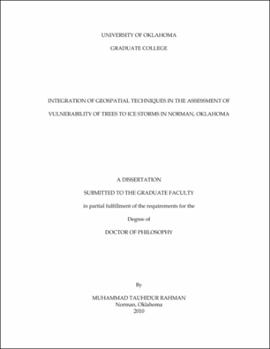| dc.contributor.advisor | Hoagland, Bruce | |
| dc.creator | Rahman, Muhammad Tauhidur | |
| dc.date.accessioned | 2019-04-27T21:27:17Z | |
| dc.date.available | 2019-04-27T21:27:17Z | |
| dc.date.issued | 2010 | |
| dc.identifier | 99206514202042 | |
| dc.identifier.uri | https://hdl.handle.net/11244/318729 | |
| dc.description.abstract | Every year, natural hazards such as hurricanes, floods, wild fires, | |
| dc.description.abstract | droughts, earthquakes, volcanic eruptions, and ice storms destroy millions of trees across the World and cause extensive damage to their species composition, structure, and dynamics. Recently within the last decade, ice storms has caused catastrophic damage to trees, infrastructures, power lines in Oklahoma, and has taken over several dozen human lives. However, studies pertaining to the vulnerability and assessment of tree damage from ice storms in Oklahoma are almost non-existent. This study aims to fulfill that | |
| dc.description.abstract | gap by first integrating remote sensing (RS) and geographic information systems (GIS) to assess and estimate tree damage caused by the December 8-11, 2007 ice storm that struck the north-central part of Oklahoma. It also explores the factors that contributed to the tree damage and created multiple regression models based on the factors. Finally, it examines the vulnerability of trees to ice storms by creating an ice storm tree damage vulnerability index | |
| dc.description.abstract | for the City of Norman, Oklahoma. | |
| dc.description.abstract | The integrated RS and GIS method assessed tree height and crown | |
| dc.description.abstract | damage with high degree of accuracy. The thickness of ice accumulation has emerged as the most important predictor, followed by tree branch angle and pre-storm crown, wind, stem, and branch diameters for tree damage from ice storms. Results indicate that the vulnerability index accurately predicted several areas that are highly vulnerable. | |
| dc.description.abstract | Results from this study are significant from both theoretical, and methodological and implication perspectives. The present study contributes significantly by identifying the geographic conditions of the City of Norman that make its urban forestry vulnerable to ice storm damage. In doing so, it initiates steps for future tree vulnerability research. Methodologically, the study contributes significantly to geospatial technology paradigm in geography by integrating RS and GIS to assess tree damage not only on a | |
| dc.description.abstract | change/no change basis, but also by quantifying the damage. Finally, the methods and techniques developed in this study can not only assess damage from future ice storms, but can also quantify damage from other natural disasters in other parts of the world as well. | |
| dc.format.extent | 166 pages | |
| dc.format.medium | application.pdf | |
| dc.language | en_US | |
| dc.relation.requires | Adobe Acrobat Reader | |
| dc.subject | Trees--Effect of ice on | |
| dc.subject | Geographic information systems | |
| dc.subject | Remote sensing | |
| dc.subject | Ice storms--Environmental aspects | |
| dc.title | INTEGRATION OF GEOSPATIAL TECHNIQUES IN THE ASSESSMENT OF VULNERABILITY OF TREES TO ICE STORMS IN NORMAN, OKLAHOMA | |
| dc.type | text | |
| dc.type | document | |
| dc.thesis.degree | Ph.D. | |
| ou.group | College of Atmospheric & Geographic Sciences::Department of Geography and Environmental Sustainability | |
